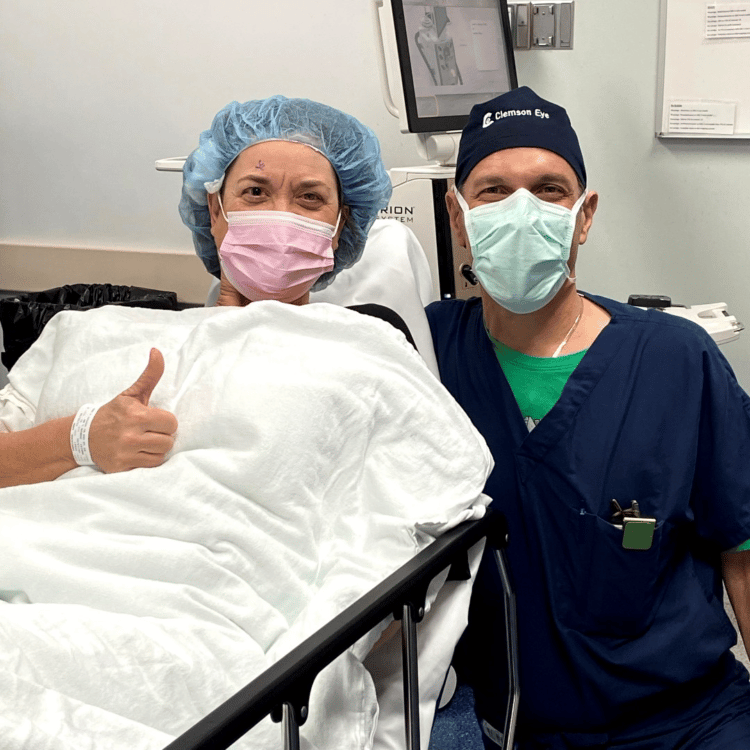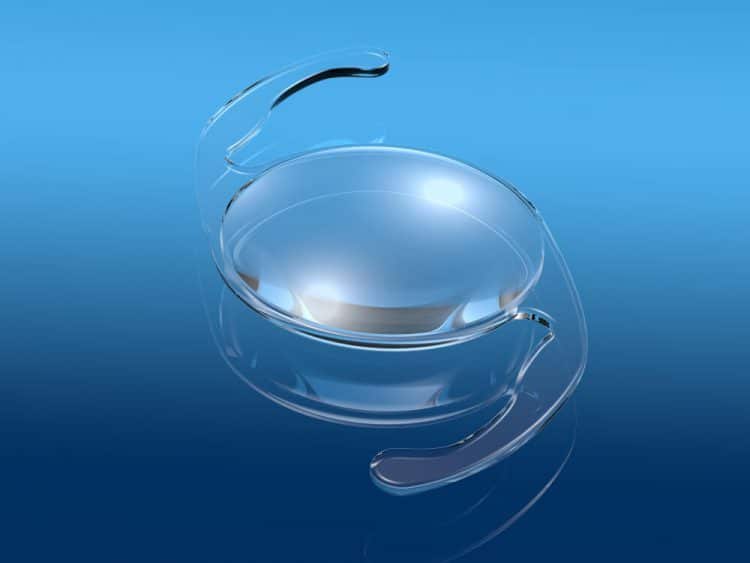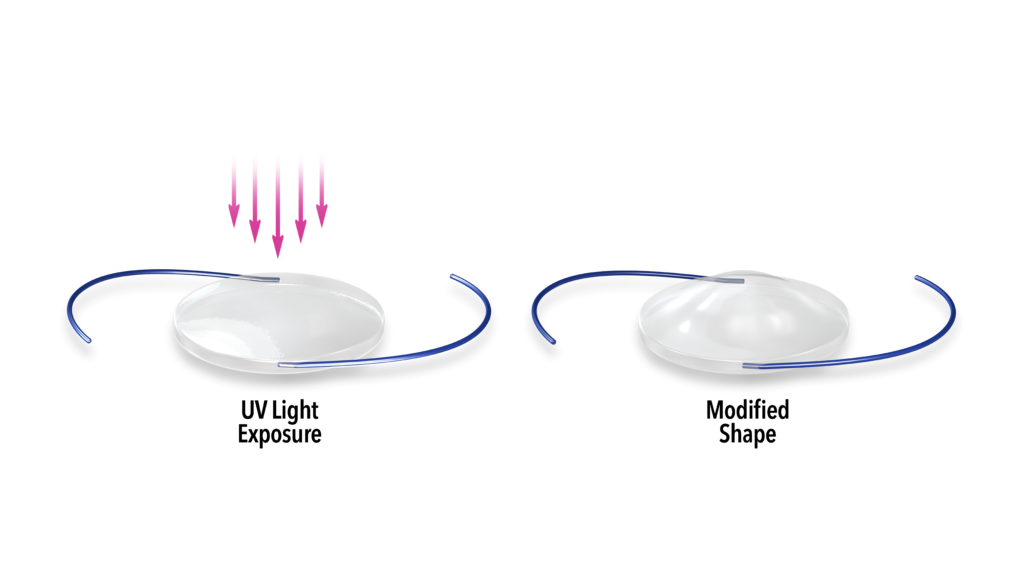
Range of Focus Lens implants have been designed to improve vision at all distances – up close, far away, and everything in between. These advanced intraocular lenses give cataract patients a chance to live free of their glasses. Range of Focus Lens implants, such as the PanOptix, Vivity, and Apthera intraocular lenses (IOL), can restore your ability to read the newspaper, sew, play cards, and drive. These Range of Focus Lens implants allow cataract patients the opportunity to see many other things near and far without the hassle of reading glasses, bifocals, progressive lenses, or contact lenses.
Recent changes to Medicare and Insurance regulations allow cataract patients to choose a new lens that provides a range of vision unlike the older single‑vision lens implants called “monofocal lenses”.
With monofocal lens implants, there is a high likelihood you will need glasses for most activities after your cataract surgery, certainly for reading and near work. This means you will also continue to have the replacement cost of glasses through the years.
Medicare and Insurance allows you to pay directly for an upgrade to a range of focus lens, while still covering the standard costs associated with basic cataract surgery. During your consultation with Clemson Eye, our surgeons will determine if you are a candidate for a range of focus lens. Candidacy depends upon your general eye health and amount of refractive error.

If you have cataracts and need to have cataract surgery, you’ll need to choose an intraocular lens. One intraocular lens that’s worth considering is the PanOptix trifocal lens.
For one thing, it’s the only trifocal lens that’s available! But there are other reasons to consider this revolutionary IOL. Whether you’re nearsighted, farsighted, or have astigmatism, the PanOptix trifocal lens can provide you with the clear vision you’ve always wanted. For patients with astigmatism, the lens uses astigmatism-correcting technology and may even reduce your need to wear glasses.
Having cataracts, it may seem like having clear vision is a distant memory. But one of the advantages of the trifocal lens is you’ll have clear vision at all times.
There are no blurry zones so you won’t need to strain to focus when you’re seeing the world around you. You’ll also experience less glare around lights, letting you enjoy everything you see.You’ll have sharper visual acuity so you don’t need to wear glasses as much
If you dream of visual freedom, the PanOptix trifocal lens will both correct and sharpen your vision. This means that you’re less likely to wear glasses.
The PanOptix trifocal lens is not right for everyone, so discuss your options during a consultation at Clemson Eye with one of our surgeons!
Used by ophthalmologists in Australia and Western Europe, the Alcon Vivity lens is the latest cutting-edge intraocular lens technology available for use in the United States. It is safe, effective, and has a higher patient satisfaction rate than other IOLs.
The Vivity lens is the first intraocular lens of its kind to be available.
The Vivity intraocular lens is an extended depth of focus lens, meaning it provides patients with excellent distance and in-between vision while also being helpful when you need to see things up close.
One thing that sets this lens apart is the Vivity lens has proprietary X-Wave technology. This technology delivers an extended focal range and allows you to see well with all available light, even if you’re in dim or very bright lighting.
The Vivity lens even protects your eyes from the sun’s harmful UV rays, as well as the blue light emitted from devices like smartphones and tablets. Many patients who use multifocal IOLs experience frustrating visual disturbances like glare, halos, or starbursts after cataract surgery.
Patients that chose the Vivity lens experience fewer side effects, making it safer for driving at night.
Although the Vivity IOL is a great choice, it may not be suitable for everyone. The only way to know for sure if it could be right for you is to schedule a cataract screening at Clemson Eye.
The Vivity lens works best if you’re looking to improve your in-between intermediate and up-close vision. If you have the Vivity lens, you may be able to read ingredients on a bag of chips while grocery shopping or a text message, but you may need reading glasses for other up-close tasks, like sewing or knitting.
You may want to think about another IOL if you have a history of eye infections or an autoimmune condition. If you have astigmatism, there is a toric lens option to ensure astigmatism and refractive errors are corrected during cataract surgery.

Astigmatism is a defect in the surface of the cornea. When astigmatism is present, the cornea is curved more like a football than a basketball, and this steeper curvature leads to blurry vision. Astigmatism is common and often present from birth.
Astigmatism-correcting monofocal lenses, like the Acrysof Toric® lens implant, have been uniquely designed to improve your vision by correcting astigmatism. Patients who choose these options will likely need reading glasses for up-close activities, but will not need glasses for distance activities such as driving and watching TV.
Your surgeon will assist you in choosing the right full focus lens for you and your lifestyle. These advanced intraocular lenses can be implanted during the same procedure to remove your cataract.
The Toric® lens is uniquely designed to improve vision. With this astigmatism-correcting lens implant, cataract patients can also have their astigmatism corrected during their cataract surgery. What would you do if you had quality vision restored, and could live without the hassle of corrective eyewear?
The Toric intraocular lens (IOL) is a foldable, single-piece lens that an eye surgeon implants during cataract surgery to replace the clouded lens and correct a more significant astigmatism. The unique design of the Toric IOL makes it possible to reduce or eliminate corneal astigmatism and significantly improve distance vision. The Toric lens provides quality single-focus vision, independent of eyeglasses and contact lenses to help correct any significant astigmatism. If freedom from eyeglasses for single-focus vision is important to you, you now have an excellent option – the Toric lens implant.
A lens with a single focal point, designed to correct cataracts and provide distance vision while offering enhanced image quality
| Near | |
| Intermediate | |
| Distance | |
| Astigmatism |
A lens with a single focal point, designed to correct both cataracts and pre-existing astigmatism, providing distance vision
| Near | |
| Intermediate | |
| Distance | |
| Astigmatism |
A premium lens designed to correct cataracts and presbyopia in order to provide a full range of vision for patients
| Near | |
| Intermediate | |
| Distance | |
| Astigmatism |
A premium lens designed to correct cataracts, astigmatism and presbyopia in order to provide a full range of vision for patients
| Near | |
| Intermediate | |
| Distance | |
| Astigmatism |
A lens with a single focal point, designed to correct cataracts and provide distance vision while offering enhanced image quality
| Near | |
| Intermediate | |
| Distance | |
| Astigmatism |
Clemson Eye is proud to be one of the first ophthalmology practices in the world to offer this revolutionary new technology to our patients.
The Cassini is a first‑of‑its‑kind Corneal Shape Analyzer. It provides more accurate measurements of a patient’s cornea, which help the eye surgeon to correct astigmatism during cataract surgery.
The Cassini measures the true axis and magnitude of corneal astigmatism. These measurements improve the eye surgeon’s ability to plan for the intraocular lens replacement. The result is better visual outcomes for cataract patients.
Through this total cornea measurement capability, we have critical information to properly select the power and position of an astigmatism‑correcting lens implant, and plan for arcuate and limbal relaxing incisions with our LenSx laser system.
Antibiotic advances also benefit patients undergoing cataract surgery. Cataract surgery is the most common surgery performed on adults in the United States. But like in all surgeries, complications can occasionally occur.
One of the most severe complications is an infection in the eye called endophthalmitis. To reduce your risk of getting endophthalmitis, your doctor will prescribe antibiotic eye drops to use around the time of your surgery. New antibiotics developed in the past few years are more effective than ever at preventing eye infections during cataract surgery.
The Light Adjustable Lens™ (LAL®) is the first and only lens that can be customized after cataract surgery—because we believe your vision should be exactly what you want. Now you can experience your vision, then refine it. So your vision will truly be yours.
With other lenses, you have to make a lot of decisions about the vision you want before your cataract surgery. Once implanted, those lenses can’t be changed; they’re what’s known as “fixed.” The Light Adjustable Lens, however, is an adjustable lens. This means that the only decision you have to make before your surgery is to choose the Light Adjustable Lens. The rest can be made after your surgery once your eye has healed. You and your surgeon then have the ability to adjust the lens and optimize your vision based on your unique preferences and lifestyle requirements. So you will truly have vision that is just for you.
The Light Adjustable Lens is made of a special photosensitive material that changes the shape and power of your implanted lens in response to ultraviolet (UV) light to optimize your vision. The Light Delivery Device (LDD) non-invasively delivers this UV light to precisely reshape your lens based on the visual correction that is needed to target your custom prescription.
